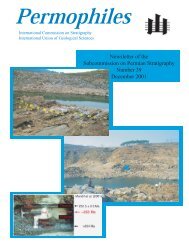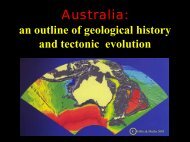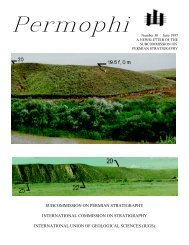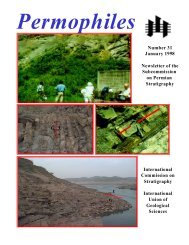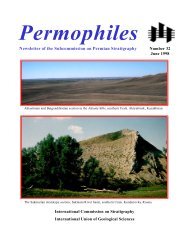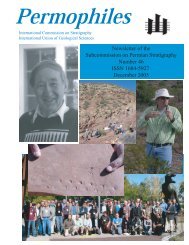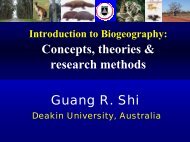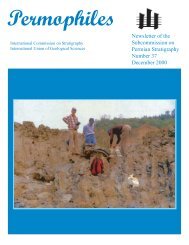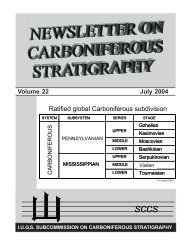Newsletter of the Subcommission on Permian Stratigraphy Number ...
Newsletter of the Subcommission on Permian Stratigraphy Number ...
Newsletter of the Subcommission on Permian Stratigraphy Number ...
Create successful ePaper yourself
Turn your PDF publications into a flip-book with our unique Google optimized e-Paper software.
taining some thin limest<strong>on</strong>e beds. In <str<strong>on</strong>g>the</str<strong>on</strong>g> upper 5 m red, <str<strong>on</strong>g>the</str<strong>on</strong>g>re arered, subordinately grey or greenish-grey shales, with thick andthin grey, partly graded cherty limest<strong>on</strong>e banks and chert. Thissequence is followed by a breccia (Baud et al., 2001a). One samplewith amm<strong>on</strong>oids was taken by Beauchamp 0.5 m above <str<strong>on</strong>g>the</str<strong>on</strong>g> pillowlava (sample KW 10A/2001) and given half <str<strong>on</strong>g>of</str<strong>on</strong>g> <str<strong>on</strong>g>the</str<strong>on</strong>g> sample to Kozur.Kozur has taken a fur<str<strong>on</strong>g>the</str<strong>on</strong>g>r sample 0.4 m above <str<strong>on</strong>g>the</str<strong>on</strong>g> pillow lava (sampleKW 10B/2001) and 9 fur<str<strong>on</strong>g>the</str<strong>on</strong>g>r samples from <str<strong>on</strong>g>the</str<strong>on</strong>g> amm<strong>on</strong>oid-free part<str<strong>on</strong>g>of</str<strong>on</strong>g> <str<strong>on</strong>g>the</str<strong>on</strong>g> secti<strong>on</strong> up to 40.4m above <str<strong>on</strong>g>the</str<strong>on</strong>g> pillow lava for investigati<strong>on</strong>soutside <str<strong>on</strong>g>the</str<strong>on</strong>g> scope <str<strong>on</strong>g>of</str<strong>on</strong>g> <str<strong>on</strong>g>the</str<strong>on</strong>g> present c<strong>on</strong>tributi<strong>on</strong> (samples KW 1-9/2001).In <str<strong>on</strong>g>the</str<strong>on</strong>g> Rustaq secti<strong>on</strong>, <str<strong>on</strong>g>the</str<strong>on</strong>g> Wordian amm<strong>on</strong>oids were found intwo thick beds <str<strong>on</strong>g>of</str<strong>on</strong>g> red pelagic limest<strong>on</strong>es with several layers rich incrinoids (Baud et al., 2001b). Numerous, well preserved Wordianamm<strong>on</strong>oids were found in several levels <str<strong>on</strong>g>of</str<strong>on</strong>g> both beds. The 1 mthick lower bed begins about 0.5 m above <str<strong>on</strong>g>the</str<strong>on</strong>g> pillow lava and c<strong>on</strong>sist<str<strong>on</strong>g>of</str<strong>on</strong>g> red pelagic limest<strong>on</strong>es with numerous amm<strong>on</strong>oids andcrinoids. These two beds were sampled by Kozur and <str<strong>on</strong>g>the</str<strong>on</strong>g> samplepoints were marked in <str<strong>on</strong>g>the</str<strong>on</strong>g> field and a few days later re-sampled inexactly <str<strong>on</strong>g>the</str<strong>on</strong>g> same sampling points by B. Beauchamp. Sample KR 2/2001 was taken from <str<strong>on</strong>g>the</str<strong>on</strong>g> base <str<strong>on</strong>g>of</str<strong>on</strong>g> <str<strong>on</strong>g>the</str<strong>on</strong>g> lower bed, sample KR1/2001 15cm higher, sample KR3/2001 from <str<strong>on</strong>g>the</str<strong>on</strong>g> upper 10 cm below <str<strong>on</strong>g>the</str<strong>on</strong>g> 1.1-1.8m thick dolomite intercalati<strong>on</strong>. The upper amm<strong>on</strong>oid-bearingbed is 1.1m thick and c<strong>on</strong>sists <str<strong>on</strong>g>of</str<strong>on</strong>g> Hallstatt Limest<strong>on</strong>e. It is subdividedinto 4 beds, from which <str<strong>on</strong>g>the</str<strong>on</strong>g> uppermost <strong>on</strong>e is partly flaserbedded.Sample KR 4/2001 was taken 0.15 m above <str<strong>on</strong>g>the</str<strong>on</strong>g> base <str<strong>on</strong>g>of</str<strong>on</strong>g> <str<strong>on</strong>g>the</str<strong>on</strong>g>limest<strong>on</strong>e, sample KR 5/2001 at 0.35 m above <str<strong>on</strong>g>the</str<strong>on</strong>g> base, sample KR6/2001 at 0.7 m above <str<strong>on</strong>g>the</str<strong>on</strong>g> base, and sample KR 7/2001 at <str<strong>on</strong>g>the</str<strong>on</strong>g> top <str<strong>on</strong>g>of</str<strong>on</strong>g><str<strong>on</strong>g>the</str<strong>on</strong>g> upper limest<strong>on</strong>e bed immediately below about 10 m <str<strong>on</strong>g>of</str<strong>on</strong>g> dolomites.The samples KW 10A,B/2001 from <str<strong>on</strong>g>the</str<strong>on</strong>g> Wadi Wasit secti<strong>on</strong> c<strong>on</strong>tainsnumerous silicified ostracods (Kozur, in prep.). They c<strong>on</strong>sistmainly <str<strong>on</strong>g>of</str<strong>on</strong>g> shallow-water ostracods, such as sculptured Bairdiidaeand Kirkbyidae and ostracods that occur both in shallow- anddeep-water, such as smooth Bairdiidae. In additi<strong>on</strong>,palaeopsychrosphaeric deep-water ostracods are never dominatingbut ra<str<strong>on</strong>g>the</str<strong>on</strong>g>r comm<strong>on</strong>. Such an ostracod fauna indicates waterdepth below <str<strong>on</strong>g>the</str<strong>on</strong>g> storm-wave base around 100 m to shallower than200 m. Fur<str<strong>on</strong>g>the</str<strong>on</strong>g>rmore, <str<strong>on</strong>g>the</str<strong>on</strong>g>y indicate that <str<strong>on</strong>g>the</str<strong>on</strong>g> area had full c<strong>on</strong>necti<strong>on</strong>to nearby cold bottom-water currents. The c<strong>on</strong>od<strong>on</strong>t fauna c<strong>on</strong>sistsalmost exclusively <str<strong>on</strong>g>of</str<strong>on</strong>g> smooth Mesog<strong>on</strong>dolella, mainly M.siciliensis, with rarer primitive specimens <str<strong>on</strong>g>of</str<strong>on</strong>g> M. omanensis n. sp.,transiti<strong>on</strong>al from M. siciliensis. M. omanensis evolved from M.siciliensis and is distinguished from this species by <str<strong>on</strong>g>the</str<strong>on</strong>g> outlineei<str<strong>on</strong>g>the</str<strong>on</strong>g>r with subparallel sides (in primitive forms) or distinctly triangular(advanced specimens). M. aserrata (J. aserrata) is rarelypresent, and is very smooth. The highest occurrence <str<strong>on</strong>g>of</str<strong>on</strong>g> smooth M.aserrata is in sample KW8/2001, about 34 m above <str<strong>on</strong>g>the</str<strong>on</strong>g> pillow lava.In <str<strong>on</strong>g>the</str<strong>on</strong>g> entire interval an open c<strong>on</strong>necti<strong>on</strong> to cold bottom-watercurrents is indicated by <str<strong>on</strong>g>the</str<strong>on</strong>g> ostracods, and by <str<strong>on</strong>g>the</str<strong>on</strong>g> c<strong>on</strong>od<strong>on</strong>ts becauseall Mesog<strong>on</strong>dolella, including M. aserrata, are basicallyunserrated.In <str<strong>on</strong>g>the</str<strong>on</strong>g> lower part <str<strong>on</strong>g>of</str<strong>on</strong>g> <str<strong>on</strong>g>the</str<strong>on</strong>g> lower amm<strong>on</strong>oid-bearing limest<strong>on</strong>e atRustaq, <str<strong>on</strong>g>the</str<strong>on</strong>g> same ostracod fauna is present, but with fewerpalaeopsychrosphaeric ostracods. The c<strong>on</strong>od<strong>on</strong>t fauna is <str<strong>on</strong>g>the</str<strong>on</strong>g> sameas in KW 10A,B/2001. Also in KR1/2001 and KR2/2001 all c<strong>on</strong>od<strong>on</strong>ts,including a few M. aserrata are smooth. The ostracodfauna with fewer palaeopsychrosphaeric forms indicates a littleshallower envir<strong>on</strong>ment than that at Wadi Wasit, but within <str<strong>on</strong>g>the</str<strong>on</strong>g>Permophiles Issue #38 200111same depth range as indicated for Wadi Wasit. A distinct changeis observed in KR 3/2001, immediately below <str<strong>on</strong>g>the</str<strong>on</strong>g> dolomite intercalati<strong>on</strong>.There, <str<strong>on</strong>g>the</str<strong>on</strong>g> same species occur, but M. aserrata is not sorare and besides <str<strong>on</strong>g>the</str<strong>on</strong>g> basically smooth forms, serrated forms arecomm<strong>on</strong>. In rare specimens, weak serrati<strong>on</strong> is even developed inM. siciliensis and M. omanensis. However, in <str<strong>on</strong>g>the</str<strong>on</strong>g> lower part <str<strong>on</strong>g>of</str<strong>on</strong>g> <str<strong>on</strong>g>the</str<strong>on</strong>g>upper amm<strong>on</strong>oid-bearing limest<strong>on</strong>e, 15 cm above <str<strong>on</strong>g>the</str<strong>on</strong>g> dolomite(sample KR4/2001), smooth forms dominate again with <strong>on</strong>ly <strong>on</strong>eweakly serrated M. aserrata. All o<str<strong>on</strong>g>the</str<strong>on</strong>g>r specimens <str<strong>on</strong>g>of</str<strong>on</strong>g> <str<strong>on</strong>g>the</str<strong>on</strong>g> rare M.aserrata, and <str<strong>on</strong>g>of</str<strong>on</strong>g> <str<strong>on</strong>g>the</str<strong>on</strong>g> comm<strong>on</strong> M. siciliensis and M. omanensis aresmooth. In sample KR5/2001 all Mesog<strong>on</strong>dolella (dominated M.siciliensis and M. omanensis with very rare M. aserrata) are smoothand palaeopsychrosphaeric ostracods re-appear. This indicates are-opening <str<strong>on</strong>g>of</str<strong>on</strong>g> <str<strong>on</strong>g>the</str<strong>on</strong>g> c<strong>on</strong>necti<strong>on</strong> to <str<strong>on</strong>g>the</str<strong>on</strong>g> cold bottom water currentsand a correlati<strong>on</strong> between palaeopsychrosphaeric ostracods andcompletely smooth Mesog<strong>on</strong>dolellas. Near <str<strong>on</strong>g>the</str<strong>on</strong>g> upper thick dolomite,<str<strong>on</strong>g>the</str<strong>on</strong>g> palaeopsychrosphaeric ostracods disappear again andseveral specimens <str<strong>on</strong>g>of</str<strong>on</strong>g> both M. siciliensis and M. omanensis showfaint serrati<strong>on</strong> <str<strong>on</strong>g>of</str<strong>on</strong>g> <str<strong>on</strong>g>the</str<strong>on</strong>g> anterior platform margin. This feature is especiallywell developed in sample KR7/2001 immediately below <str<strong>on</strong>g>the</str<strong>on</strong>g>upper thick dolomite. Thus, two times, typically smoothMesog<strong>on</strong>dolella exhibit faint serrati<strong>on</strong> when <str<strong>on</strong>g>the</str<strong>on</strong>g> open c<strong>on</strong>necti<strong>on</strong>to <str<strong>on</strong>g>the</str<strong>on</strong>g> cold bottom water currents was interrupted. In sample KR6and 7/2001 M. siciliensis is progressively more replaced by M.omanensis, which is represented by more and more advanced formswith triangular outline.In additi<strong>on</strong> to <str<strong>on</strong>g>the</str<strong>on</strong>g> amm<strong>on</strong>oids, c<strong>on</strong>od<strong>on</strong>ts and ostracods, reefdebris is present in <str<strong>on</strong>g>the</str<strong>on</strong>g> Wadi Wasit secti<strong>on</strong>, and some silicifiedfusulinids were found in <str<strong>on</strong>g>the</str<strong>on</strong>g> insoluble residues from Rustaq. Col<strong>on</strong>ialreef corals and numerous sculptured Bairdiidae indicate tropicalwarm-water c<strong>on</strong>diti<strong>on</strong>s. This suggests <str<strong>on</strong>g>the</str<strong>on</strong>g> presence <str<strong>on</strong>g>of</str<strong>on</strong>g> reefs(close to Wadi Wasit) and a small carb<strong>on</strong>ate platform (Rustaq)similar to depositi<strong>on</strong> near atolls today.The above menti<strong>on</strong>ed results show <str<strong>on</strong>g>the</str<strong>on</strong>g> extraordinary importance<str<strong>on</strong>g>of</str<strong>on</strong>g> <str<strong>on</strong>g>the</str<strong>on</strong>g> Rustaq and Wadi Wasit secti<strong>on</strong>s for <str<strong>on</strong>g>the</str<strong>on</strong>g> correlati<strong>on</strong> <str<strong>on</strong>g>of</str<strong>on</strong>g> <str<strong>on</strong>g>the</str<strong>on</strong>g>Tethyan stratigraphy and above all for <str<strong>on</strong>g>the</str<strong>on</strong>g> correlati<strong>on</strong> with <str<strong>on</strong>g>the</str<strong>on</strong>g>type Wordian in <str<strong>on</strong>g>the</str<strong>on</strong>g> Delaware Basin which make <str<strong>on</strong>g>the</str<strong>on</strong>g>m to a criticalanchor point for <str<strong>on</strong>g>the</str<strong>on</strong>g> Wordian <str<strong>on</strong>g>of</str<strong>on</strong>g> <str<strong>on</strong>g>the</str<strong>on</strong>g> Tethys. The main results are:1) The Tethyan Wordian key amm<strong>on</strong>oid fauna <str<strong>on</strong>g>of</str<strong>on</strong>g> Sosio type in <str<strong>on</strong>g>the</str<strong>on</strong>g>Wadi Wasit and Rustaq secti<strong>on</strong>s c<strong>on</strong>tains dominantly smoothMesog<strong>on</strong>dolella (M. siciliensis, M. omanensis), but this c<strong>on</strong>od<strong>on</strong>tfauna is accompanied by very rare to moderately comm<strong>on</strong> M.aserrata (J. aserrata), <str<strong>on</strong>g>the</str<strong>on</strong>g> index species <str<strong>on</strong>g>of</str<strong>on</strong>g> <str<strong>on</strong>g>the</str<strong>on</strong>g> type Wordian in<str<strong>on</strong>g>the</str<strong>on</strong>g> Delaware Basin. This c<strong>on</strong>firms also by c<strong>on</strong>od<strong>on</strong>ts <str<strong>on</strong>g>the</str<strong>on</strong>g> Wordianage <str<strong>on</strong>g>of</str<strong>on</strong>g> <str<strong>on</strong>g>the</str<strong>on</strong>g> Sosio-type amm<strong>on</strong>oid fauna which is accepted by allTethyan <strong>Permian</strong> stratigraphers since Miller (1933, Heritsch (1933,1940) and Kahler (1939).2) The co-occurrence <str<strong>on</strong>g>of</str<strong>on</strong>g> M. siciliensis and M. aserrata c<strong>on</strong>firmsby c<strong>on</strong>od<strong>on</strong>ts <str<strong>on</strong>g>the</str<strong>on</strong>g> Wordian age <str<strong>on</strong>g>of</str<strong>on</strong>g> <str<strong>on</strong>g>the</str<strong>on</strong>g> M. siciliensis c<strong>on</strong>od<strong>on</strong>tfauna within <str<strong>on</strong>g>the</str<strong>on</strong>g> Wordian Sosio-type amm<strong>on</strong>oid fauna.3) Guadalupian c<strong>on</strong>od<strong>on</strong>t faunas <str<strong>on</strong>g>of</str<strong>on</strong>g> open sea Tethyan envir<strong>on</strong>mentwith open c<strong>on</strong>necti<strong>on</strong> to <str<strong>on</strong>g>the</str<strong>on</strong>g> cold bottom water currents c<strong>on</strong>tainin situ <strong>on</strong>ly smooth Mesog<strong>on</strong>dolella. Even M. aserrata in thisenvir<strong>on</strong>ment is typically unserrated. When <str<strong>on</strong>g>the</str<strong>on</strong>g> open c<strong>on</strong>necti<strong>on</strong>to <str<strong>on</strong>g>the</str<strong>on</strong>g> cold bottom water currents is interrupted, M. aserrata displayscomm<strong>on</strong> serrati<strong>on</strong>s and generally smooth forms such as M.siciliensis and M. omanensis also exhibit faint serrati<strong>on</strong>s <str<strong>on</strong>g>of</str<strong>on</strong>g> <str<strong>on</strong>g>the</str<strong>on</strong>g>anterior platform.A very interesting parallel evoluti<strong>on</strong> can be observed in <str<strong>on</strong>g>the</str<strong>on</strong>g>



